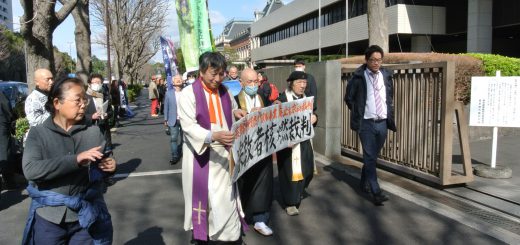CNIC Statement: Regarding Comments on the Nuclear Fuel Cycle by Liberal Democratic Party Presidential Election Candidates
Published in Japanese on September 23, 2021
We would like to point out that there have been serious misunderstandings about the nuclear fuel cycle in the discussions associated with the current Liberal Democratic Party presidential election.
In a candidates’ debate at the Japan National Press Club on September 18, former Foreign Minister Kishida Fumio said, “If the nuclear fuel cycle is stopped, high-level nuclear waste that should be disposed of will remain as it is. The disposal period for the waste is said to be 300 years if it is reprocessed, but it is said that it would take 100,000 years if the high-level nuclear waste were disposed of directly. How are we to consider this problem of disposal? Stopping the nuclear fuel cycle will lead to increasingly large accumulations of plutonium. This may develop into a diplomatic issue for Japan, including with the Japan-U.S. nuclear agreement. How are we to consider this problem? I think that stopping the nuclear fuel cycle may possibly result in the emergence of other problems.”
In the first half of his statement, Mr. Kishida addressed the solution to the issue of nuclear waste through the nuclear fuel cycle, while in the second half he addressed the diplomatic issues related to plutonium. In the first half, in addition to the errors, Mr. Kishida appears to harbor the misunderstanding that the problem of high-level radioactive waste can be solved simply by the reprocessing of nuclear fuel. The second half is just wrong.
Mr. Kishida stated, “The disposal period for the waste is said to be 300 years if it is reprocessed.” However, this is not the “disposal period,” but the period called by the Agency for Natural Resources and Energy the “toxicity reduction period,” which is something completely different. Furthermore, “reprocessing” in this case does not refer to the reprocessing of spent fuel at the Rokkasho Nuclear Fuel Reprocessing Facility, now under construction in Rokkasho Village, Aomori Prefecture. This could only be achieved by constructing a second reprocessing plant (total cost estimated at present at 13.5 trillion yen), for which plans do not yet exist, and by constructing more than a dozen fast breeder reactors and/or fast reactors, which have already failed despite the investment of more than 1 trillion yen, and which would have to be operated for several decades. It is misleading to explain the problem as if reprocessing spent fuel would solve the problem.
The latter half of Mr. Kishida’s statement, “Stopping the nuclear fuel cycle will lead to increasingly large accumulations of plutonium,” is simply wrong. The reprocessing of spent fuel results in the separation of, and therefore an increase in, plutonium. If nuclear power plants stop using MOX fuel (mixed uranium-plutonium oxide fuel), the consumption of plutonium would no longer be possible, but then there would be no increase in the amount of plutonium unless spent fuel was reprocessed. Historically, during the Carter administration, the United States expressed concern over reprocessing by Japan, and since that time has maintained a watchful eye on Japan’s plutonium stockpile. Thus, it is rather the reprocessing that has caused diplomatic problems.
In an NHK Sunday Debate on September 19, former Minister of Internal Affairs and Communications Ms. Takaichi Sanae said, “For as long as nuclear power plants continue to be operated, we simply cannot stop the [nuclear fuel] cycle.” Mr. Kishida also stated, “If the cycle is stopped, the disposal of high-level waste will become a problem, and thus it should be maintained.” His view is that if reprocessing is stopped, spent fuel will have nowhere to go and therefore nuclear power plants will have to be shut down. This also shows errors in awareness. At present, the only countries in the world that are both using nuclear energy and are reprocessing spent fuel are France, Russia and India. No other country is conducting reprocessing, and there has also been no progress in the means of final disposal of radioactive waste. Nevertheless, the situation in which there is nowhere to put spent fuel has not yet arisen. This is because many countries are promoting the dry storage of spent fuel.
The reason why the spent fuel pools at Japan’s nuclear power plants are currently nearly out of space is that while nuclear power plant operators have secured storage capacity for spent fuel on the assumption that it could be reprocessed at the Rokkasho Nuclear Fuel Reprocessing Facility, the initiation of operation of the facility itself has been postponed no less than 25 times. Thus, the origin of the spent fuel pool problem is rather the nuclear fuel cycle policy that is focused on the reprocessing of spent fuel.
The Rokkasho Nuclear Fuel Reprocessing Facility is a huge undertaking with a price tag of 14.4 trillion yen; 16.9 trillion yen if the MOX fuel fabrication plant is included. If it is operated, it will release vast amounts of radioactive materials into the sea and the atmosphere. Should such a project be promoted simply because power companies have no place to store spent fuel? Rather than pursue the dream of an infeasible fast reactor cycle, could we not have policy discussions that are based on reality?

